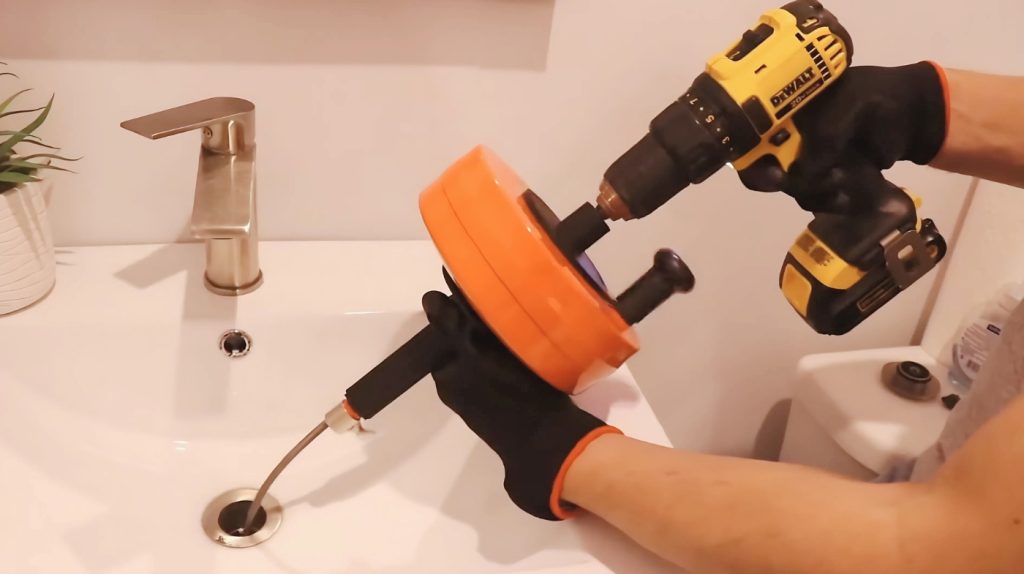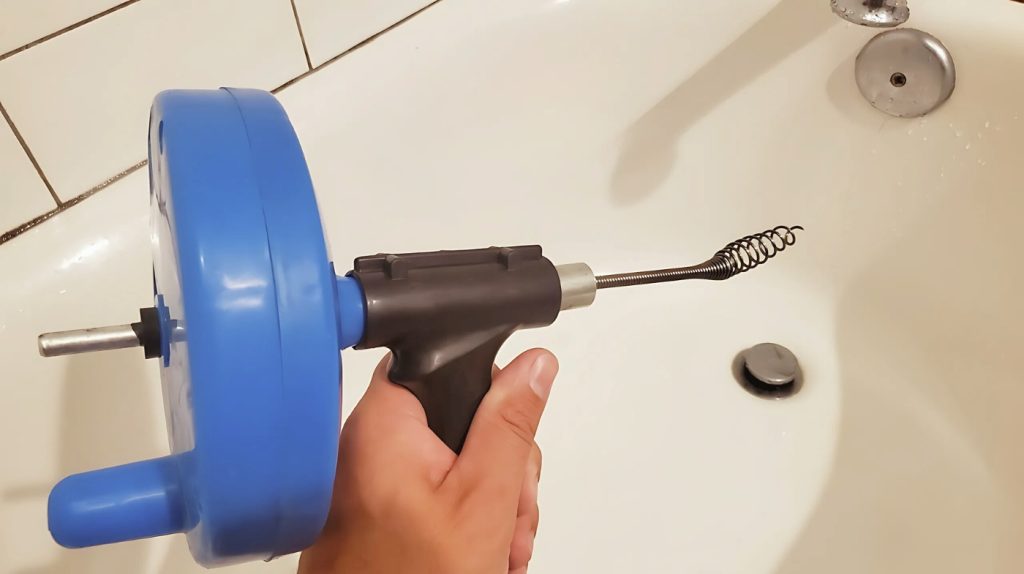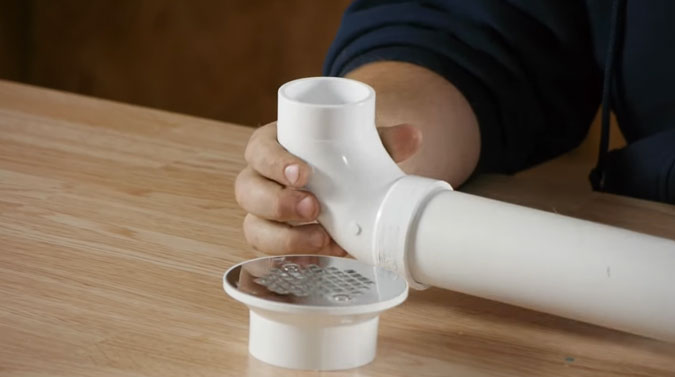Last Updated on February 18, 2025
To use a plumber’s auger, first insert the auger’s head into the drain until you feel resistance. Next, turn the handle clockwise while applying gentle pressure to push through the clog.
If the cable gets stuck, rotate it further to break apart the blockage. Once the clog clears, retract the cable and clean the auger thoroughly.
For best results, know what type of auger to use and familiarize yourself with proper safety precautions, and there’s more important info ahead.
Key Takeaways
- Begin by inserting the auger’s head into the drain until it meets resistance, indicating a clog.
- Rotate the handle clockwise to engage the corkscrew head and break apart the clog.
- Continue pushing and rotating the auger to dislodge the obstruction while pulling it back slightly to remove debris.
- Once the clog is cleared, retract the cable slowly while rotating to avoid tangling.
- Clean the auger thoroughly after use, ensuring it is dry and stored properly to prevent rust.
Understanding the Plumber’s Auger
A plumber’s auger, also known as a drain snake, is an essential tool for anyone dealing with clogged drains. Its primary purpose is to clear obstructions in pipes and drains.
The design features a long, flexible metal cable with a corkscrew-like head that effectively breaks up and removes blockages. Basic components include a rotating handle, the cable itself, and a specialized head for dislodging clogs.
Featuring a flexible metal cable and a corkscrew head, the plumber’s auger excels at breaking up tough clogs.
Often used in conjunction with plungers and chemical cleaners, the auger allows plumbers to tackle stubborn clogs quickly and efficiently. Essential tool for plumbers in unclogging drains and pipes, the auger helps avoid the use of chemical drain cleaners.
The term ‘drain auger’ comes from the French word ‘auger,’ meaning ‘to bore’, reflecting its historical significance in plumbing tool evolution. This tool is vital for both professionals and DIY enthusiasts alike.
Types of Augers: Manual vs. Motor-Driven
When dealing with clogged drains, understanding the different types of augers can greatly enhance your plumbing efforts.
Manual augers, operated by a hand crank, are effective for medium-level clogs and are budget-friendly, making them ideal for residential use like kitchen sinks and bathroom drains.
However, they require more physical effort, especially for stubborn blockages. Cable augers can reach multiple feet into drains, making them a versatile option for locating and pulling out clogs.
In contrast, motor-driven augers utilize a motor or power drill for faster, more efficient operation, excelling at handling deeper and tougher clogs, often suited for professional use.
While motor-driven models are more expensive, they reduce physical strain and automate cable feeding. Your choice depends on the severity of the clog, your budget, and how often you maintain your drains.
Choosing the Right Auger for Your Clog
How do you determine the right auger for your specific clog? Start by evaluating the severity of the clog and its location. Consider the type of plumbing and the drain size to find a compatible auger.
The following table summarizes key factors:
| Factor | Manual Auger | Motorized Auger |
|---|---|---|
| Severity of Clog | Mild to moderate | Severe |
| Length Requirement | Shorter cables | Longer cables |
| Drain Compatibility | PVC and metal pipes | PVC and metal pipes |
| Typical Use Location | Sinks and tubs | Main sewer lines |
It’s important to note that understanding the types of augers available will help you make a more informed decision when selecting the right tool for your needs.
Safety Precautions to Consider
Using a plumber’s auger can be an effective method for clearing clogs, but it’s crucial to prioritize safety throughout the process.
Always wear protective gear like safety glasses, gloves, and durable clothing to shield yourself from splashes and debris. Be aware of potential hazards in the drain, such as chemical cleaners or sharp objects, and avoid loose clothing that could get caught in the equipment.
Plumbing augers are designed to dislodge clogs effectively, but using them improperly can lead to accidents. If you handle chemical cleaners, make certain you’ve waited for them to clear and wear specialized protective gear.
When using electric augers, connect to GFI outlets, keep machines grounded, and avoid overextending cords. After use, clean your tools and wash your hands thoroughly to prevent bacterial transmission and maintain hygiene.
Step-by-Step Guide to Using a Plumber’s Auger

With safety precautions firmly in place, you’re ready to tackle the clog with a plumber’s auger.
Start by preparing your environment: place a drop cloth under the drain and wear protective gloves. Assess the clog’s location to determine if you need to remove the P-trap for better access.
Prepare your workspace by placing a drop cloth and wearing protective gloves, then assess if the P-trap needs removal for better access.
Next, set up the auger, selecting the right size and type, and remove any covers. Insert the auger cable slowly, noting any resistance, and pull out an extra 6 to 8 inches for workspace.
To break up the clog, rotate the handle and apply moderate pressure. After clearing the obstruction, retract the cable, inspect it for debris, and run water to verify proper drainage.
This tool is especially useful for clogs that are too tough for natural remedies or plungers. Clean and store the auger appropriately.
Common Challenges and How to Overcome Them
While you may feel confident tackling clogs with a plumber’s auger, several common challenges can arise that require careful attention.
It’s essential to be aware of potential damage to pipes, personal safety concerns, and operational issues with the auger. To overcome these obstacles, consider the following tips:
- Inspect pipes: Always assess the age and material of your pipes before using an auger to prevent punctures or abrasions.
- Wear protective gear: Use gloves and safety glasses to minimize the risk of injury from snapping cables.
- Choose the right auger: Make certain you’re using the appropriate type of auger for the specific clog to enhance effectiveness and avoid complications.
Maintenance Tips for Your Auger
Proper maintenance of your plumber’s auger is key to ensuring its longevity and peak performance. Follow these essential tips to keep your auger in top shape:
| Maintenance Task | Recommended Action | Frequency |
|---|---|---|
| Cable Inspection | Check for damage or wear; replace if needed | Before each use |
| Lubrication | Apply specialized oils to prevent rust | Monthly |
| Drum Cleaning | Remove debris buildup to maintain function | After each use |
| Drive Belt Check | Inspect for wear; replace as necessary | Every 6 months |
Additionally, regular cable inspections are crucial for identifying potential issues before they lead to more significant problems.
Proper Storage Techniques
After using your plumber’s auger, cleaning it thoroughly is crucial to prevent buildup and guarantee peak performance. Implement rust prevention methods, such as drying components and using protective covers, to maintain the integrity of the auger.
Additionally, ensure that you clear clogs effectively by using the auger as intended to avoid unnecessary wear and tear. Finally, organize your toolbox effectively to maximize accessibility and prolong the life of your tools.
Cleaning After Use
To guarantee your plumber’s auger remains in peak condition, it’s essential to clean it immediately after use. Start by soaking the auger in hot water mixed with antibacterial detergent to loosen any debris.
Use a scrubbing brush and a wire pipe cleaner to tackle stubborn remnants. After scrubbing, rinse thoroughly with clean water to eliminate all soap residue.
- Dry the auger completely using newspapers or old rags to prevent moisture buildup. Ensure the auger is completely dry before storage to avoid rust and deterioration over time.
- Store the auger in a dry location to maintain its condition.
- Wind the cable neatly to avoid tangles during storage.
Following these steps guarantees your auger stays functional and hygienic, ready for your next plumbing task.
Rust Prevention Methods
Maintaining your plumber’s auger in good condition doesn’t stop at cleaning; effective rust prevention methods are key to prolonging its life.
Start by storing your auger in a clean, dry environment to prevent moisture accumulation. Use dehumidifiers to manage humidity levels, and consider placing silica gel packs in your toolbox to absorb excess moisture.
Regularly inspecting your auger for signs of rust is essential, as monitoring and adjusting water pressure can also help prevent corrosion. Regularly inspect your auger for signs of rust, addressing any issues promptly.
Apply rust inhibitors like WD-40 to protect metal surfaces. Guarantee your storage area has good air circulation and stable temperatures to minimize rust formation.
Organized Toolbox Placement
Organized toolbox placement is essential for maximizing efficiency and ensuring that tools are easily accessible. Start by placing heavier tools at the bottom of your toolbox to maintain stability.
Sort your tools by function and frequency of use, and utilize compartments such as clear plastic trays to keep everything organized. A labeling system can markedly enhance your workflow, allowing you to quickly identify where each tool belongs.
Store frequently used tools at waist height for easy access. Sort tools by function and use foam inserts for custom tool storage, keeping items separated and easily retrievable.
Position your toolbox close to your workstation to minimize movement and enhance productivity. Implement these techniques, and you’ll streamline your plumbing tasks effectively.
When to Call a Professional
When should you call a professional plumber? If you notice multiple drains clogging simultaneously, it may signal a blockage in your sewer system, requiring immediate attention.
Additionally, a clogged discharge pipe can lead to further plumbing issues if not addressed promptly. Visible water backups in sinks or toilets are also critical signs that you shouldn’t ignore.
If your auger fails to clear persistent clogs, especially those deep within main sewer pipes, it’s time to seek expertise. Furthermore, issues like tree root intrusions or pipe collapses demand specialized tools and knowledge.
Be aware of leaks and low water pressure, as these may indicate hidden damage. Regular maintenance can help prevent these issues from escalating.
For complex repairs or emergency situations, such as overflowing toilets, don’t hesitate to contact a professional to prevent further damage and guarantee effective resolution.
Frequently Asked Questions
Can I Use an Auger on a Kitchen Sink Drain?
Absolutely, you can use an auger on a kitchen sink drain. Think of it as a knight’s sword, ready to battle the stubborn clog lurking deep within.
By carefully accessing the drain, you can release the auger’s power to break up debris and restore flow.
Just make sure you’re equipped with safety gear and tackle the task methodically, as this tool’s effectiveness shines when used correctly in challenging situations.
How Do I Know if My Auger Is Damaged?
To determine if your auger is damaged, inspect the cable for kinks, breaks, or fraying. Check the drum for integrity and guarantee the crank mechanism operates smoothly.
Look at the auger head for any signs of damage or loose connections. Also, verify that all connectors and fittings are secure.
Conduct a visual check and test the cable’s flexibility to confirm it can maneuver bends without issues. Regular maintenance helps prevent further damage.
What Type of Gloves Should I Wear for Protection?
When diving into plumbing, think of your hands as valuable tools that need protection. You should wear gloves that offer chemical resistance, like nitrile or PVC-coated options, to shield against harsh substances.
For tasks involving sharp objects, kevlar gloves are a must. Look for features like textured grips and safety cuffs for better control and wrist protection.
Comfort matters too, soft inner linings will keep your hands happy during long jobs.
How Often Should I Clean My Auger After Use?
You should clean your auger after each use to prevent bacterial buildup and guarantee peak performance.
Fully extend and retract the cable to remove debris, applying a suitable cleaning solution where necessary. Rinse the cable thoroughly and dry it to prevent rust.
Proper storage is also essential for maintaining the integrity of the device, so always keep it in a dry, safe place after cleaning.
Regular maintenance extends the life of your auger considerably.
Are There Specific Tips for Different Types of Clogs?
For hair clogs, try removing the blockage gently to avoid damage. Grease clogs require heat to break down the buildup, while soap scum clogs need a good scrub or chemical solution.
For food particles, using strainers can prevent future issues. Finally, mineral buildup often needs a descaling solution—address these specific types to keep your plumbing flowing smoothly.
Safety First: Tips for Using an Auger Effectively
Using a plumber’s auger can be as satisfying as untangling a knot in a rope; the right technique can clear your drains and restore flow. Remember to choose the right type for your clog, prioritize safety, and maintain your auger properly for longevity.
While DIY solutions can save you money, don’t hesitate to call a professional if your efforts don’t yield results. With patience and practice, you’ll be well-equipped to tackle most plumbing challenges that come your way.


